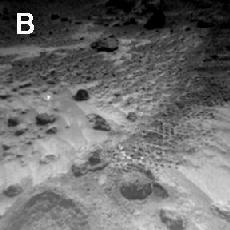This image shows the Mars Pathfinder lander and Rover.
Click on image for full size
NASA/JPL
An Overview of the Mars Pathfinder Mission
The goal of the Mars Pathfinder (MPF) mission was to analyze the
rocks and
soil of Mars. The MPF was actually 2 parts, a lander and a rover. The lander stayed right where it landed while the rover named "Sojourner" could roam the surface.
In its study of the Martian terrain near the landing site, Pathfinder found sand dunes, pebbles, wind drifts and other evidences of a changing surface. MPF also had the chance to explore Martian weather.
There was great excitement when Pathfinder landed on the surface of Mars on July 4, 1997. That excitement continued throughout the mission as the Rover was highly successful in exploring the geology of Mars. NASA's Mars Pathfinder mission was last heard from on September 27, 1997. It did operate on the surface of Mars three times longer than expected! Overall, the Pathfinder mission handed scientists tons of new knowledge about Mars!
You might also be interested in:

This diagram shows the path traveled by the Mars Pathfinder Rover during its 80 day mission. In addition to sampling the atmosphere, and the Martian soil, during it's travels on the Martian surface, the
...more
This image shows pebbles found in the lee of a large rock. Pebbles found at the Mars Pathfinder landingsite were rounded, suggesting that water once flowed in the region, carrying rocks with it. The pebbly
...more
This is the first image showing clouds of Mars taken from the lander. Ground based viewing of Mars has shown that clouds seem to be plentiful only in the middle latitudes As early as 1796 scientists were
...more
The Mars Pathfinder mission was able to find out that the rocks of Mars can be studied in a way that is similar to the very same rock cycle on the Earth. Mars Pathfinder also verified that regions of Mars
...more
During it's travels on the Martian surface, Mars Pathfinder's Rover examined many different rocks as well as the Martian soil. These studies and measurements made during previous missions to Mars have
...more
NASA has announced the next mission to visit the planet Mars. The Mars Exploration Program Rover will start its journey in 2003 and should reach the Red Planet in 2004. This rover will be a more advanced
...more
On Mars the surface winds accelerate to higher speeds than those on Earth. The general circulation pattern of winds is also very different from the terrestrial circulation pattern. These winds can be whipped
...more
If approved, the Mars 2003 mission will have two important parts. The first is the Mars Surveyor 2003 Lander, which will be launched sometime between May 27, 2003, and June 17, 2003. The lander will use
...more













